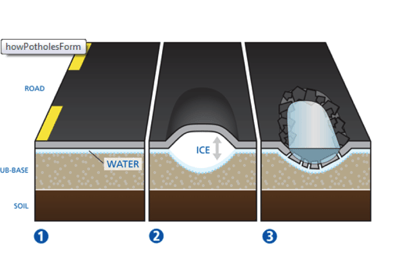Asphalt is sensitive. More sensitive than you think actually. And as seasons change so do the temperatures. And whether it’s during cold months or hot your asphalt is being affected by the weather.

Darn potholes!
Potholes are mysterious creatures, one day you’re driving along happy as can be and the next, wham! Pothole. It couldn’t be avoided by the time you noticed it. The ensuing “clunk” so commonly associated with your suspension being thrown out of whack can cost you. Visit VDOT to understand more about what to do if you hit a pothole.
Colder months cause freezing above and below the surface of asphalt. Leading to potholes. Warmer months can bring pounding heat and UV rays which over time can crack and strip the asphalt roads, parking lots and driveways, also leading to raveling and potholes.
During freeze thaw cycles the pavement is subjected to the worst conditions. Once an opening appears, water seeps into the pavement. It expands and contracts during freeze-thaw cycles and in sufficient quantities, water washes out the lower layers of stone and dirt supporting the surface layer.
 In warmer climates not subject to freeze-thaw cycles, the problem begins with heat-caused deterioration. Cracks from the heat allow water in, eroding the sub-surface layers. An air gap is formed in the sub-base of the pavement.
In warmer climates not subject to freeze-thaw cycles, the problem begins with heat-caused deterioration. Cracks from the heat allow water in, eroding the sub-surface layers. An air gap is formed in the sub-base of the pavement.
As vehicles pass over these sub-surface gaps, the top layer sags, collapse and crumble. Voilà, a pothole is born.
Asphalt Parking Lots
Protect your parking lot! Conduct preventative asphalt maintenance. Maintenance is generally planned in advance to seal the surface from water, as well as lessen effects of oxidation and weather. Apply a sealant every few years to keep the surface layer of asphalt protected.
Steeper terrain impacts asphalt erosion.
When it rains in steeper elevations, little by little rain washes away the liquid asphalt leaving bare rock and aggregate. The aggregates and asphalt break away and wind up in run-off, gutters and storm drains.
Asphalt’s love hate with heat.
You might say asphalt is born of heat and ultimately dies by heat. When asphalt is laid it’s important that at the time asphalt is placed the asphalt is hot enough because hot asphalt compacts the best. On the other side of the coin, once it’s compacted and placed, heat and damaging UV rays on hot days cause asphalt to dry and crack.
Can you predict behavior of asphalt based on the season?
Sort of. As temperatures get colder asphalt is more brittle and harder to work with. Also, potholes form during freeze and thaw cycles.
By now, you’re probably wondering “what’s liquid asphalt?”.
Liquid asphalt is a petroleum based product, scraped from the bottoms of crude oil barrels. It’s the thickest, most viscous part of the crude and it’s used to bond aggregates like rock and stone together. When it’s hot outside, liquid asphalt is subject to UV rays, causing it to crack and pull away from aggregates, or it can be washed away by water over time. Either way, asphalt pavement is only as good as the liquid asphalt binding it together.
Knowing how the seasons affect asphalt can be a great benefit when driving. Keeping your eyes peeled, especially during winter months and wet months, can help you avoid potholes. And if you happen to own an asphalt parking lot, road or driveway, preparing your asphalt for the seasonal effects on asphalt can help you maintain the life of your asphalt investment.


